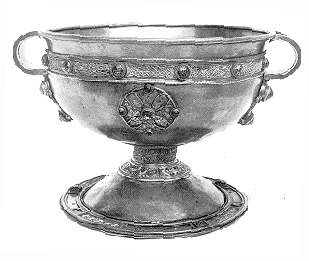|
 |
 |
| 資源型式:
|
| 提供者:Marguerite Connor 康慕婷;
Cecilia Liu 劉雪珍 |
|

|
(附圖一: The
acme of Irish Christian metallurgy, 7th-8th century, (from How
the Irish Save Civilization)
|
Anglo-Saxon Period
|
| |
 The "Cernunnos" figure with animals and
plants.
The torgue in the figure's right hand is similar
to the torque that the Dying Gaul wears around his neck.
(from How the Irish Save Civilization)
The "Cernunnos" figure with animals and
plants.
The torgue in the figure's right hand is similar
to the torque that the Dying Gaul wears around his neck.
(from How the Irish Save Civilization)
|
| |
 Early History of England Early History of England
 Religion Religion
 Anglo-Saxon Poetry Anglo-Saxon Poetry
 Major Works Major Works
|
| |
 Early
History of England Early
History of England |
| |
The
island was originally inhabited by Celtic
tribes from Central Asia prior to the invasion by the Romans c.
50-100CE. Some of the Celts, a brave, fierce, and what we
would call barbaric people, fled west over the mountains to what is now
Wales and further over to Ireland. The rest stayed and
intermarried with the invading Romans. The Romans brought
architecture, art, "civilization," Christianity and most important,
literacy. They stayed in the land, founding the cities that are today
London (then Londinium) and Wincester, but during the fall of the Roman
Empire c. 450-500 CE, the Roman soldiers left, leaving the now-softened
Celtic people.
This left the
natives open to attacks from the neighboring Picts
(from what is today Scotland) and Jutes
(a Germanic tribe). The Celts
called for help from the Angles and Saxons, tribes from the area that
is the modern Germany - Denmark area. The Angles
and Saxons saved the Celts, but then turned against them
and settled in England, becoming the Anglo-Saxons who lived in
Angle-Land (-- England).
These
Anglo-Saxons were brave, rude, reckless, adventurous and
barbaric. They did not have much of a written culture, but
they brought with them a rich folk-lore tradition, with long epics
recited by scops, the poets of the clan. These recitations,
the earliest English Literature, was finally written down by Christian
monks in the 10th and 11th centuries.
|
| |
 Religion Religion |
| |
While the
Romans brought Christianity to the land, it was not until around 650 CE
that England was fully Christianized. The native religions
were dominated by the earth-based religion Druidism, but there were a
number of smaller traditions being practiced. These were not
destroyed, but pushed underground in greatly diminished numbers, only
to be resurfacing in the later part of this century. Pieces
of these older religions can be found thoughout English
literature.
(附圖一: The
acme of Irish Christian metallurgy, 7th-8th century, (from How
the Irish Save Civilization)
|
| |
 Anglo-Saxon
Poetry Anglo-Saxon
Poetry |
| |
There
were a number of qualities found in Anglo-Saxon poetry:
- Heroic
behavior is praised
- Almost no
romantic love
- An overall
effect to formalize and elevate language, often through the use of
literary devices. For instance:
- Synecdoche:
a part used to express the whole, or vice versa. Ex: 50
sails=50 boats
- Metonymy:
the naming of a person, institution, or human characteristic by some
object or attribute with which is closely associated. Ex: Crown,
Majesty= Ruler
- kenning:
a compound of two words in place of another. Ex: whale-road=sea,
loaf-giver = king, life-house = body
- litotes:
ironic understatement; an emphatic expression through an ironic
understatement. Ex: "he's no beauty."
- A very
common theme is "ubi sunt" "where have they gone?"
This was a rough, hard time of life. The average age for men
was 45, for women, 36. It was not totally unusual to lose
one's entire family to war, famine or some other calamity.
|
| |
 Major
Works Major
Works |
| |
Beowulf |
| |
|
|
| |
|
|
|
|
|
|
